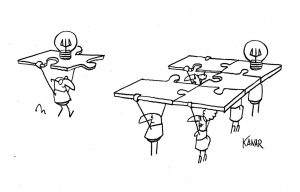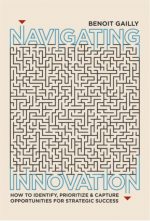 The value of an innovative opportunity – “the egg” – must be assessed, taking into account how and how much it fits with the portfolio of innovative and non-innovative projects currently pursued by an organization – “the baskets”.
The value of an innovative opportunity – “the egg” – must be assessed, taking into account how and how much it fits with the portfolio of innovative and non-innovative projects currently pursued by an organization – “the baskets”.
 How an innovation opportunity will affect the consistency of the corporate portfolio should be assessed, in terms of both the potential critical resources bottlenecks – in particular management’s and customers’ attention – and the potential technological and organizational synergies.
How an innovation opportunity will affect the consistency of the corporate portfolio should be assessed, in terms of both the potential critical resources bottlenecks – in particular management’s and customers’ attention – and the potential technological and organizational synergies.
 How much an innovation opportunity will affect the balance and alignment of the corporate portfolio should be assessed, both in terms of strategic scope – exploitation vs. exploration – and with respect to the time horizon – short-, mid- and long-term.
How much an innovation opportunity will affect the balance and alignment of the corporate portfolio should be assessed, both in terms of strategic scope – exploitation vs. exploration – and with respect to the time horizon – short-, mid- and long-term.
Bibliography
Managing a portfolio of opportunities
Keywords: portfolio management, synergies
- (Book) Cooper, Robert Gravlin, Scott J. Edgett, and Elko J. Kleinschmidt. Portfolio management for new products. Basic Books, 2001.
- (Video) Innovation Portfolio Management: The logical, non-sexy yet effective approach from Maddock Douglas, Inc (on Vimeo)
- (Article) Cooper, R., Edgett, S., & Kleinschmidt, E. (2001). Portfolio management for new product development: results of an industry practices study. R&D Management, 31(4), 361-380.
- (Article) Engwall, M. (2003). No project is an island: linking projects to history and context. Research Policy, 32(5), 789-808.
- (Article) Floricel, S., & Ibanescu, M. (2008). Using R&D portfolio management to deal with dynamic risk. R&d Management, 38(5), 452-467.
- (Article) Kang, W., & Montoya, M. (2014). The impact of product portfolio strategy on financial performance: The roles of product development and market entry decisions. Journal of Product Innovation Management, 31(3), 516-534.
- (Article) Kester, L., Griffin, A., Hultink, E. J., & Lauche, K. (2011). Exploring portfolio decision‐making processes. Journal of product innovation management, 28(5), 641-661.
- (Article) Lee, R., Lee, J. H., & Garrett, T. C. (2019). Synergy effects of innovation on firm performance. Journal of Business Research, 99, 507-515.
- (Article) Mikkola, J. H. (2001). Portfolio management of R&D projects: implications for innovation management. Technovation, 21(7), 423-435.
- (Article) Paulson, A.S., O’Connor, G.C., & Robeson, D. (2007). Evaluating radical innovation portfolios. Research-Technology Management, 50(5), 17-29.
- (Article) Smit, H.T., & Trigeorgis, L. (2006). Strategic planning: valuing and managing portfolios of real options. R&D Management, 36(4), 403-419.
Building consistent innovation portfolios
Keywords: consistency, modularity, technology roadmap
- (Book) Archibald, Russell D., and Shane Archibald. Leading and Managing Innovation: What Every Executive Team Must Know about Project, Program, and Portfolio Management. CRC Press, 2016.
- (Video) Embracing Agile, Darrell K. Rigby, Jeff Sutherland, Hirotaka Takeuchi
- (Article) Campagnolo, D., & Camuffo, A. (2010). The concept of modularity in management studies: a literature review. International Journal of Management Reviews, 12(3), 259-283.
- (Article) Daim, T. U. (2013). Are formal technology integration processes needed for successful product innovations?. International Journal of Innovation Management, 17(04), 1350016.
- (Article) Garcia-Vega, M. (2006). Does technological diversification promote innovation?: An empirical analysis for European firms. Research policy, 35(2), 230-246.
- (Article) Hoetker, G. (2006). Do modular products lead to modular organizations?. Strategic Management Journal, 27(6), 501-518.
- (Article) Kim, S. K., & Min, S. (2015). Business model innovation performance: When does adding a new business model benefit an incumbent?. Strategic Entrepreneurship Journal, 9(1), 34-57.
- (Article) Klingebiel, R., & Rammer, C. (2014). Resource allocation strategy for innovation portfolio management. Strategic Management Journal, 35(2), 246-268.
- (Article) Nieto-Rodriguez, A. (2016). How to Prioritize Your Company’s Projects, Harvard Business Review. . Accessed December 15 2017.https://hbr.org/2016/12/how-to-prioritize-your-companys-projects
- (Article) Ocasio, W. (1997). Towards an attention‐based view of the firm. Strategic Management Journal, 18(S1), 187-206.
- (Article) Phaal, Robert, Clare JP Farrukh, and David R. Probert. “Technology management tools: concept, development and application.” Technovation 26.3 (2006): 336-344.
- (Article) Rodríguez-Duarte, A., Sandulli, F. D., Minguela-Rata, B., & López-Sánchez, J. I. (2007). The endogenous relationship between innovation and diversification, and the impact of technological resources on the form of diversification. Research Policy, 36(5), 652-664.
- (Article) Sanchez, R., & Mahoney, J. T. (1996). Modularity, flexibility, and knowledge management in product and organization design. Strategic Management Journal, 17(S2), 63-76.
- (Article) Schilling, M. A. (2000). Toward a general modular systems theory and its application to interfirm product modularity. Academy of Management Review, 25(2), 312-334.
- (Article) Schilling, M. A., & Steensma, H. K. (2001). The use of modular organizational forms: An industry-level analysis. Academy of Management Journal, 44(6), 1149-1168.
- (Article) Schultz, C., Salomo, S., & Talke, K. (2013). Measuring new product portfolio innovativeness: How differences in scale width and evaluator perspectives affect its relationship with performance. Journal of Product Innovation Management, 30(S1), 93-109.
- (Article) Simonse, L.W., Hultink, E. J., & Buijs, J. A. (2015). Innovation roadmapping: Building concepts from practitioners’ insights. Journal of Product Innovation Management, 32(6), 904-924.
- (Article) Srivastava, M. K., & Gnyawali, D. R. (2011). When do relational resources matter? Leveraging portfolio technological resources for breakthrough innovation. Academy of Management Journal, 54(4), 797-810.
Staying the course: balanced and aligned portfolios
Keywords: balance, time horizons
- (Book) Baghai, M., Coley, S., & White, D. (2000). The alchemy of growth: Practical insights for building the enduring enterprise. Da Capo Press.
- (Video) The Zinnovants “Why innovate?”
- (Article) Bauer, M., & Leker, J. (2013). Exploration and exploitation in product and process innovation in the chemical industry. R&D Management, 43(3), 196-212.
- (Article) Bingham, C.B., Furr, N.R., & Eisenhardt, K.M. (2014). The opportunity paradox. MIT Sloan Management Review, 56(1), 29.
- (Article) Chao, R. O., & Kavadias, S. (2008). A theoretical framework for managing the new product development portfolio: When and how to use strategic buckets. Management science, 54(5), 907-921
- (Article) Cooper, R. G., Edgett, S. J., & Kleinschmidt, E. J. (2000). New problems, new solutions: making portfolio management more effective. Research-Technology Management, 43(2), 18-33.
- (Article) Cooper, R. G. (2013). Where are all the breakthrough new products?: Using portfolio management to boost innovation. Research-Technology Management, 56(5), 25-33.
- (Article) Eggers, J. P. (2012). All experience is not created equal: Learning, adapting, and focusing in product portfolio management. Strategic Management Journal, 33(3), 315-335.
- (Article) Heising, W. (2012). The integration of ideation and project portfolio management—A key factor for sustainable success. International Journal of Project Management, 30(5), 582-595.
- (Article) Hitt, M. A., Hoskisson, R. E., & Kim, H. (1997). International diversification: Effects on innovation and firm performance in product-diversified firms. Academy of Management journal, 40(4), 767-798.
- (Article) Kaiser, M. G., El Arbi, F., & Ahlemann, F. (2015). Successful project portfolio management beyond project selection techniques: Understanding the role of structural alignment. International Journal of Project Management, 33(1), 126-139.
- (Article) Lumpkin, G. T. and Brigham, K. H. (2011), Long-Term Orientation and Intertemporal Choice in Family Firms. Entrepreneurship Theory and Practice, 35: 1149–1169.
- (Article) Markides, C.C. (2013). Business model innovation: What can the ambidexterity literature teach us?. The Academy of Management Perspectives, 27(4), 313-323.
- (Article) Meskendahl, S. (2010). The influence of business strategy on project portfolio management and its success—a conceptual framework. International Journal of Project Management, 28(8), 807-817.
- (Article) Miller, D. J. (2006). Technological diversity, related diversification, and firm performance. Strategic Management Journal, 27(7), 601-619.
- (Article) Mohammad, A., Maryam, A., and Ebrahim-Sharifi, T. (2014) Selecting balanced portfolios of R&D projects with interdependencies: a cross-entropy based methodology. Technovation, 34, 54–63.
- (Article) Piscitello, L. (2004). Corporate diversification, coherence and economic performance. Industrial and Corporate Change, 13(5), 757-787.
- (Article) Quintana-García, C., & Benavides-Velasco, C. A. (2008). Innovative competence, exploration and exploitation: The influence of technological diversification. Research Policy, 37(3), 492-507.
- (Article) Schilling, M. A., & Hill, C. W. (1998). Managing the new product development process: strategic imperatives. Academy of Management Perspectives, 12(3), 67-81.
- (Article) Smith, W.K., & Tushman, M.L. (2005). Managing strategic contradictions: A top management model for managing innovation streams. Organization Science, 16(5), 522-536.
- (Article) Smith, D., & Sonnenblick, R. (2013). From budget-based to strategy-based portfolio management: a six-year case study. Research-Technology Management, 56(5), 45-51.
- (Article) Tuff, G., & Nadji, B. (2012). Managing your innovation portfolio. Harvard Business Review, https://hbr.org/2012/05/managing-your-innovation-portfolio. Accessed December 15 2017.
(c) Prof. Benoit Gailly, Louvain School of Management


